ISSN ONLINE(2319-8753)PRINT(2347-6710)
ISSN ONLINE(2319-8753)PRINT(2347-6710)
S. Sreehari Sastry1, K. Lakshmi Sarada2, K. Mallika2, L. Tanuj Kumar2, Ha Sie Tiong3
|
| Related article at Pubmed, Scholar Google |
Visit for more related articles at International Journal of Innovative Research in Science, Engineering and Technology
In this paper, thermo optical properties of homologous series of hydrogen bonded liquid crystals: p-n alkyl benzoic acid (nBA): heptyl p - hydroxybenzoate (7HB) (where n=5 to 10) have been investigated by means of applying Image analysis technique in conjunction with Polarizing Optical Microscope. Textures of liquid crystal complexes are captured. The changes in textural features as a function of temperature are useful to compute the thermo optical properties. These microscopic textures are analysed using MATLAB software. The investigated thermo optical parameters are optical transmission, Absorption coefficient, Phase retardation, birefringence and order parameter. Experimentally, this is a simple technique to observe the behaviour of the optical parameters of different liquid crystals as a function of temperature
Keywords |
| Liquid crystals, Hydrogen bond, Thermo optical parameter, Textures, Image analysis |
INTRODUCTION |
| Liquid crystal complexes formed through the hydrogen bonding interactions of complementary molecules are studied extensively [1-5]. The main interaction in the synthesis of such of hydrogen bonded liquid crystals is due to their thermal stability, molecular shapes and structures, high directionality and dynamics for chemical and biological processes in nature [6-9]. In recent years, liquid crystal complexes have become more important as novel materials for display applications like flat panel displays, electro optic displays, optical switches, photovoltaic cells, Fluorescent films etc [10-16]. The phase transitions and optical behaviour of the complexes are considerable properties for those applications. Liquid crystal complexes formed by the hydrogen bonds between mesogenic and non mesogenic compounds exhibit the interesting properties. Complexes of unlike molecules (mesogenic and non mesogenic) producing liquid crystals frequently involve donor molecules derived from carboxylic acids and acceptor molecules derived from pyridine, benzoates, aniline, etc [17-20]. This paper deals with homologous series of mesogenic materials: p-n alkyl benzoic acid (nBA): heptyl p - hydroxybenzoate (7HB) (where n=5 to 10). The thermo optical properties (including phase transition behaviour) are investigated using image analysis technique in conjunction with POM on MATLAB platform. There are several techniques to study the temperature dependence optical properties of liquid crystals [21-24], but they involve the technical difficulties in measuring required parameters. In image analysis technique textures of liquid crystal complexes are captured from the solid phase of the sample to the isotropic phase using POM and the changes in textural features as a function of temperature is useful to compute the thermo optical properties of samples. Image analysis technique has been developed to aid the interpretation of microscopic images and to extract as much information as possible from image objects by means of applying some computational algorithms on image data or intensity values. MATLAB R, a software product by Math Works, Inc., (Natick, MA) [25,26] is used for the analysis of liquid crystal textures. A systematic investigation on thermo optical parameters of the systems such as optical transmission, Absorption coefficient, Phase retardation, birefringence and order parameter are carried out. |
EXPERIMENTAL |
| Materials: |
| The used chemical ingredients p-n alkyl benzoic acid (nBA) where n=5 to 10, heptyl p - hydroxybenzoate (7HB) are the products of Frinton laboratory, New Jersey, USA. The purity of the studied compounds is 99%. The phase transition temperatures of pure p-n alkyl benzoic acid and its complexes are p-n alkyl benzoic acid (nBA): heptyl p - hydroxybenzoate (7HB) (where n=5 to 10) can be found in [27]. The phase transition temperatures measured by us is in good agreement with the standard techniques. |
| Method: |
| A small quantity of sample is placed on a commercially available glass slide usually which will be kept in the hot stage of the Polarizing Optical Microscope (Meopta DRU 3 Model) to observe the textures of the samples. The accuracy of the temperature measurements is ± 0.10C. The thickness of the liquid crystal slide is measured using travelling microscope technique and the thickness is equal to 100 μ m. |
| Canon EOS Digital REBEL XS/ EOS1000D is a digital single lens reflex camera with a 10.10 mega pixel image sensor is used to record the texture images of the sample through the crossed polarizer’s of the POM. The image is having 3888X2592 pixel size depicting 24 bit tonal levels in a true colour production within the range of 0 to 255 gray levels in each three primary spectral frequency of red, green and blue separately. Thermo optical parameters of the complexes of three primary wavelengths are computed as a function of temperature using MATLAB software. |
DETERMINATION OF PARAMETERS |
| The behaviour of light with respect to temperature and material is defined in terms of thermo optical properties and are measured using optical parameters like optical transmission, Absorption coefficient, Phase retardation, Phase stability, and birefringence, order parameter. These optical properties provide important information regarding the molecular ordering, molecular dynamics and type of molecular interactions in the sample. In liquid crystal complexes the hydrogen bond interactions profoundly influence the thermal properties of liquid crystalline phases, viz., melting points, enthalpies, and thermal stability. Therefore, it is necessary to investigate the thermo optical properties of liquid crystal complexes. Thermo optical properties of liquid crystals are defined in terms of image intensity values as follows. |
| Optical transmittances of the mesogens are measured by computing average transmitted intensity of the image texture recorded from the crossed polarizer’s condition and given as [28] |
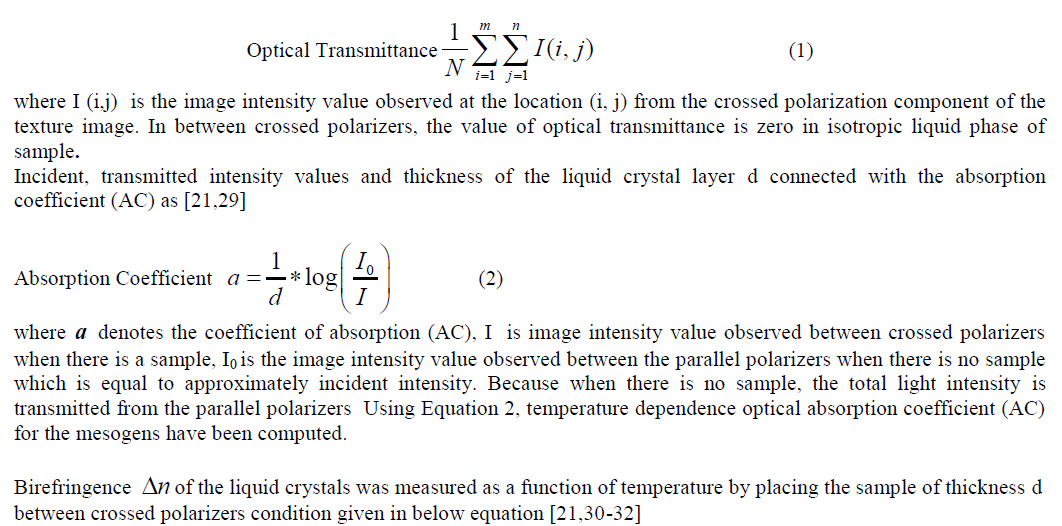 |
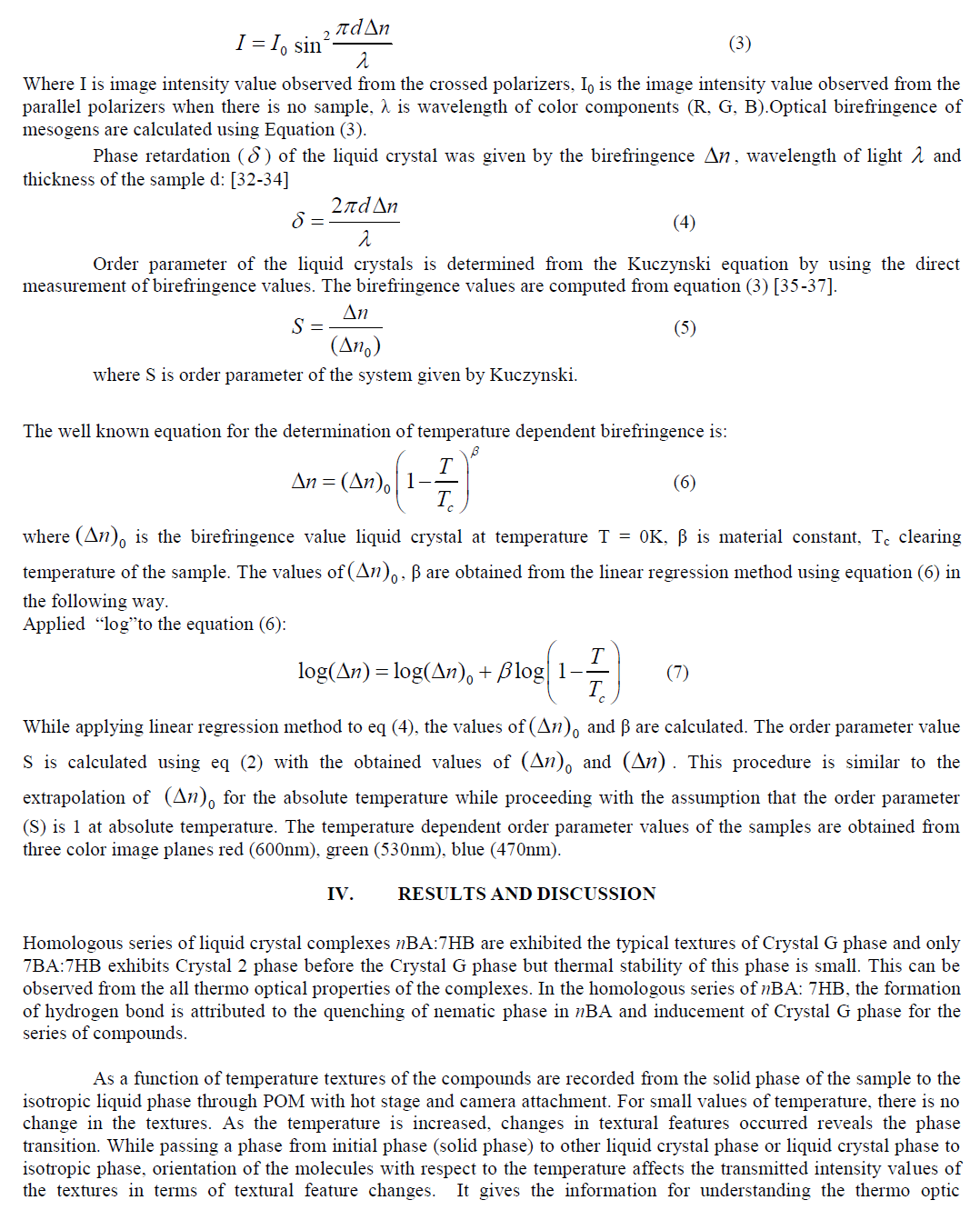 |
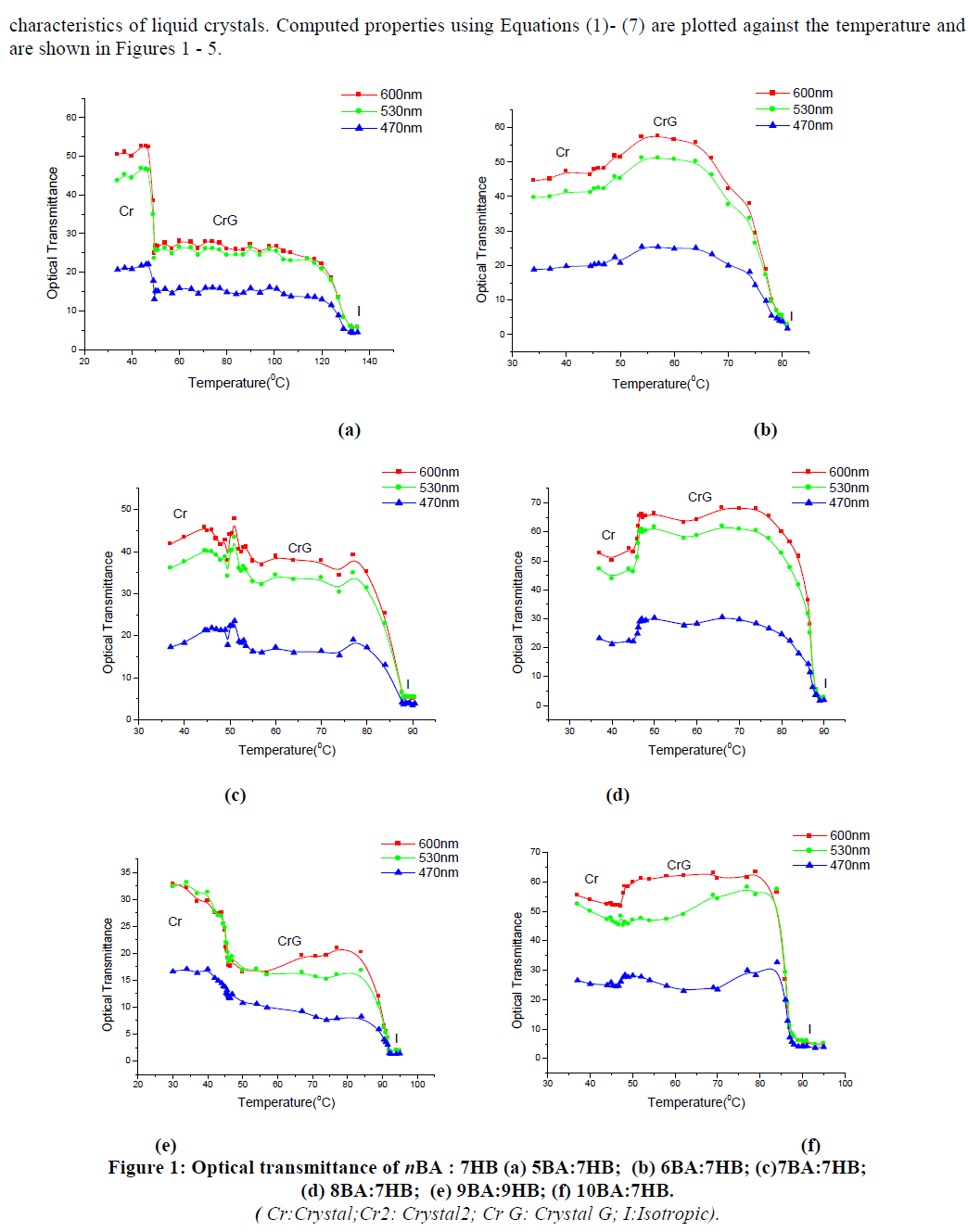 ' ' |
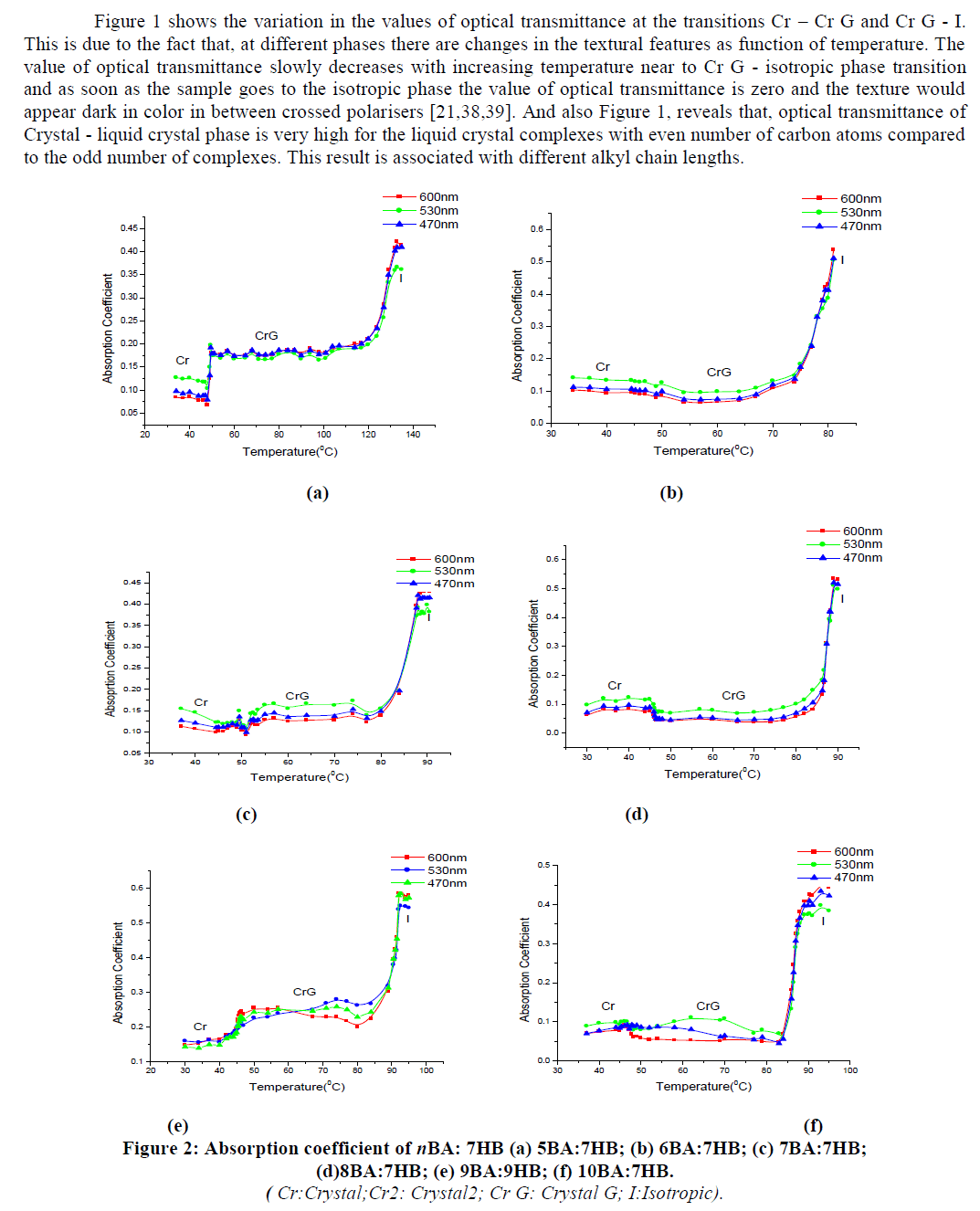 |
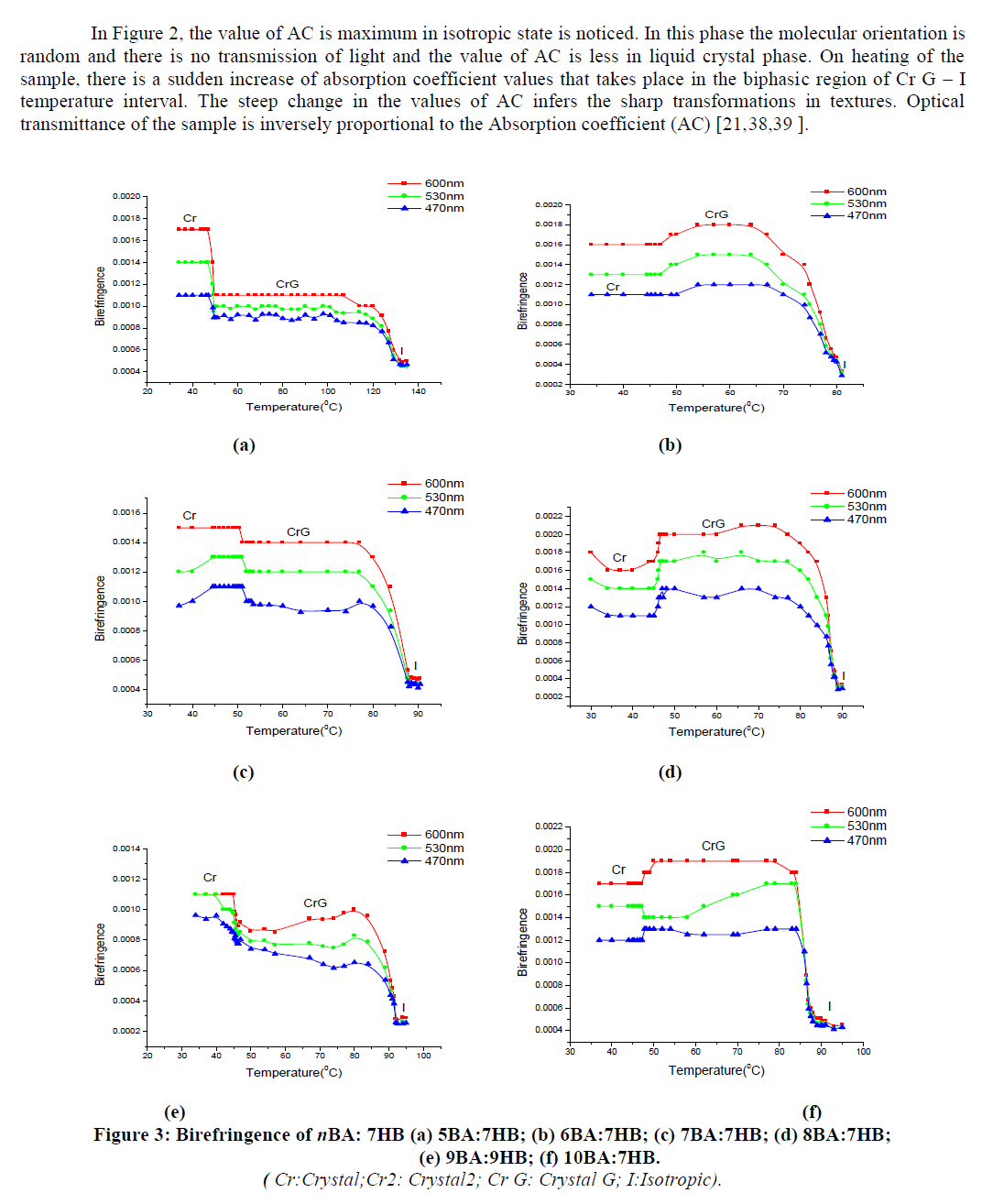 |
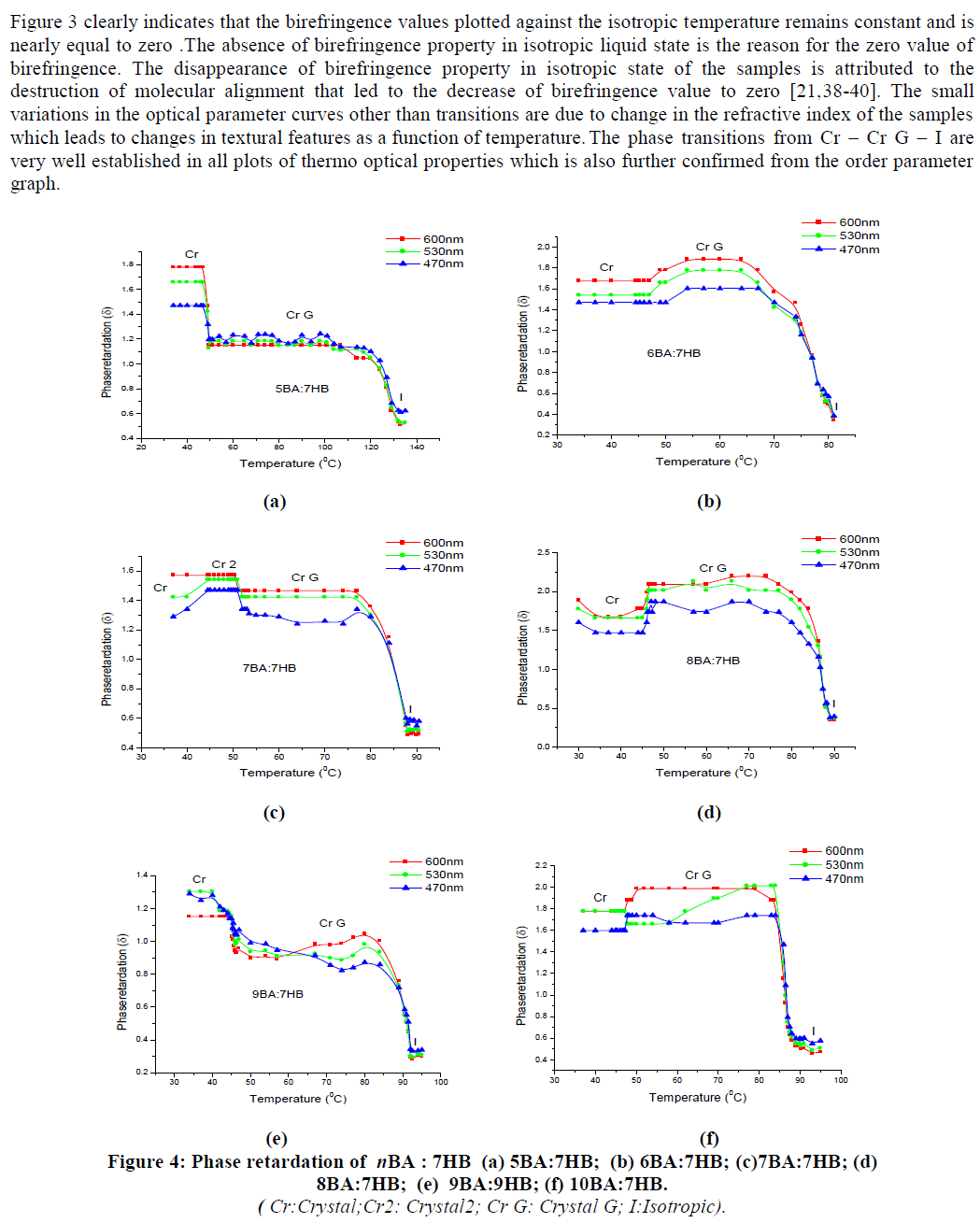 |
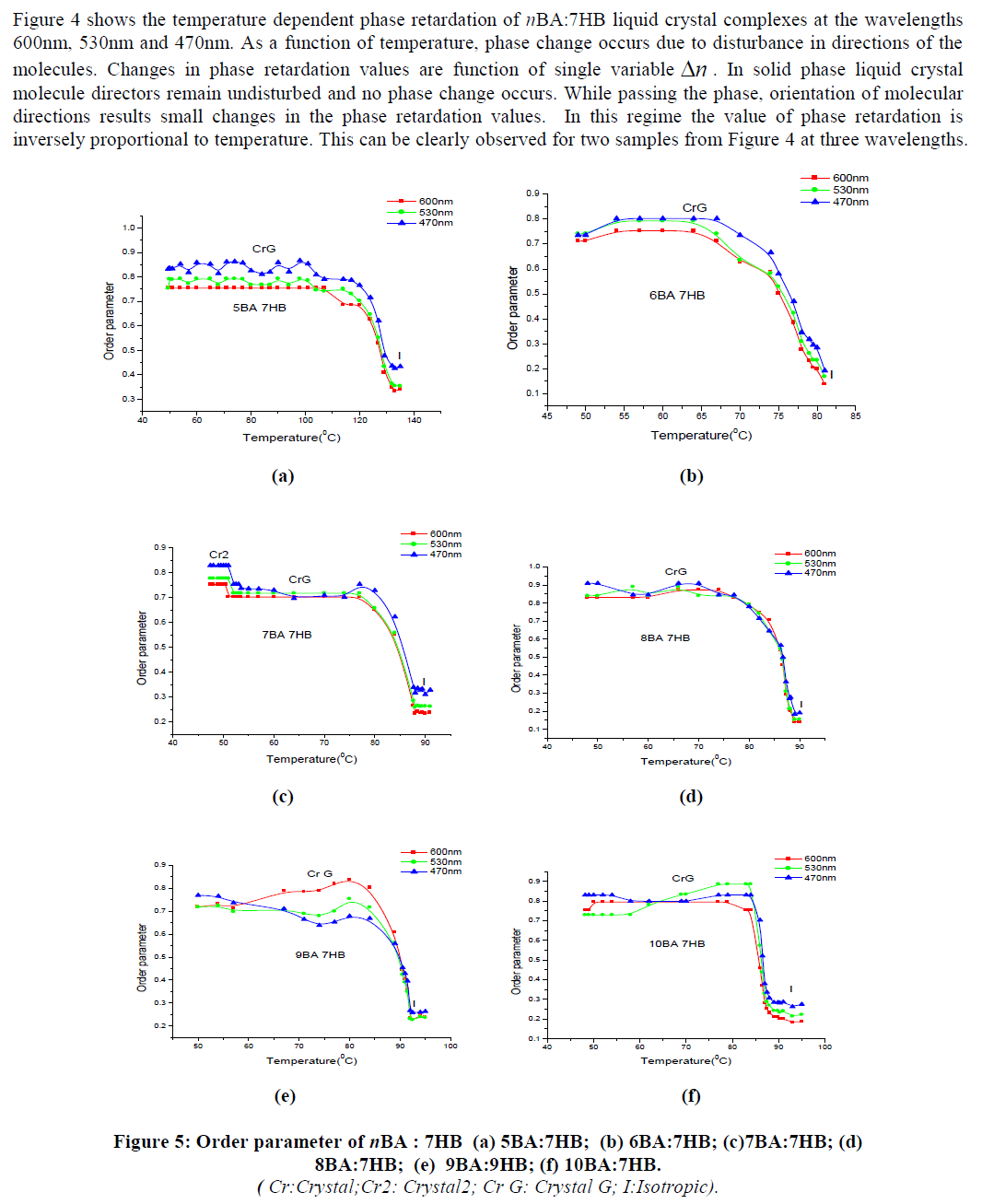 |
| The temperature dependent birefringence values of the samples obtained from Equation (3) are used to compute the temperature dependent order parameter of the nBA:7HB complexes. These measurements are made in the phase transition regions of Cr – Cr G - I phase of the sample and the measured order parameter values are plotted against the temperature. The order parameter (S) shown in Figure 5 is maximum in Cr – Cr G transition state and it goes on decreasing as the temperature is incremented towards the isotropic phase of the sample which has the lowest order parameter of the order of 0.15. The values of order parameter during the transition from the Cr – Cr G - I phases are in the range of 0.85 to 0.15. Here the parameters are computed purely based on gray level intensity vales of the image textures [41,42], where as in the other case the parameters are obtained based on the light transmitted intensity, molecular polarizabilities, refractive indices and densities of the sample etc [31,37,41] . Order parameter values plotted against temperature in Figure 5 also evince the different transitions in nBA:7HB mesogens. |
CONCLUSION |
| Thermo optical properties of homologous series of hydrogen bonded liquid crystals: p-n alkyl benzoic acid (nBA): heptylp - hydroxybenzoate (7HB) (where n=5 to 10) are investigated using Image analysis technique on MATLAB plat form. As a function of temperature, the sample undergoes different phase transitions showing different textures. Textural features of the samples in relation to temperature provided the information approximately suitable to determine the optical properties of the samples. The computed thermo optical parameters all plotted against temperature well established the different transitions and their corresponding transition temperatures in nBA:7HB mesogens under investigation. |
ACKNOWLEDGMENTS |
| The authors gratefully acknowledge University Grants Commission Departmental Research Scheme at Level III program No. F.530/1/DRS/2009 (SAP-1), dated 9 February 2009, and Department of Science and Technology -Fund for Improving Science and Technology program No. DST/FIST/PSI –002/2011 dated 20-12-2011, New Delhi, to the department of Physics, Acharya Nagarjuna University for providing financial assistance. |
References |
|